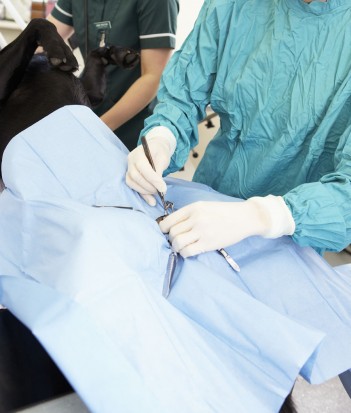This Kit will help a lot during natural disasters.
FAMILY PREPAREDNESS
Preparing for natural disaster, whether it's a hurricane, tsunami, flood, or some other event can mean the difference between life and death. Taking the time to assemble a Disaster Supply Kit before a disaster strikes will help cope with the temporary loss of everyday conveniences. What would you do without food, water, and electricity? Your supply kit should be built around basic items that help cope with these and other potential personal hardships.
The time to prepare a disaster supplies kit is now. During an emergency, supplies are in high demand and stores run out of inventory quickly. Once disaster hits, there isn't time to search for supplies.
The American Red Cross recommends six basics to stock at home: water, food, first-aid supplies, clothing, bedding, tools and emergency supplies, and special items. A good rule of thumb is to have enough supplies to cover your household for at least three days. Keep items you would most likely need during an evacuation in an easy-to-carry container.
For more information, contact your county civil defense agency or local chapter of the American Red Cross.
Below are guidelines to consider for basic disaster supplies.
WATER
Store 1 gallon of water per person per day (2 quarts for drinking, 2 quarts for food preparation and sanitation). Keep at least a 3-day supply of water for each person in your household.
To purify water for safe drinking supply:
* Boil vigorously 1 - 3 minutes; or
* Use purification tablets available at most drug stores. Follow package directions; or
* Use household bleach (must contain 5.24% hypochlorite.) For one gallon of water, add 8 drops if water is clear; if water is cloudy, add 16 drops (1/4 teaspoon). For five gallons of water, if water is clear, add teaspoon; if cloudy, 1 teaspoon. Let water stand at least 30 minutes before drinking.
FOOD
Store at least a 3-day supply of nonperishable food. Select items that don't require refrigeration, preparation, or cooking, or require little or no water. * Include selections from the food list below in your Disaster Supply Kit.
Ready -to -eat canned meats, fruits and vegetables. Canned juices, milk, soup. If powdered, store extra water. Staples - sugar, salt, pepper, etc. High energy foods - peanut butter, jelly, crackers, granola bars, trail mix. Vitamins Foods for infants, elderly or persons on special diets. Do not use left-over baby food if not refrigerated. Comfort foods -cookies, hard candy, sweetened cereals, instant coffee, tea, etc. Extra pet food
WHEN THE POWER GOES OUT
Without electricity, food in refrigerators and freezers will spoil. If you know in advance that power will be shut off: Use perishable foods in refrigerator and freezer first. Make extra ice. Freeze extra freeze-pack inserts and keep them frozen for emergencies.
Buy a cooler. Freeze water in plastic containers, do not fill to top before freezing - allow for expansion. Know where to buy dry ice. 25 lbs. of dry ice should hold a 10-cubic-foot freezer cold for 3-4 days. Note: dry ice may be limited on some islands.
FOOD SAFETY
How long food remains frozen in the freezer depends on the amount, type, temperature, and freezer insulation. Keep freezer door closed for as long as possible to prevent loss of cold air. Large cuts of meat or poultry will stay frozen longer than baked goods or small items. In fully-loaded separate freezers, food may remain frozen for 48 to 72 hours. Food thaws quicker in a refrigerator/freezer, but should remain frozen about 12 hours or longer in a side-by-side unit or up to 24 hours in a top or bottom-mount freezer.
Use refrigerated foods as soon as possible. It is difficult to make general recommendations about food safety as this depends on the type of food, its preparation, and handling. Some guidelines:
Butter, margarine, and hard cheese are safe unless it has mold or a rancid odor. Fresh fruits and vegetables are safe as long as they are not mushy or slimy. Eggs will be safe for several days if shells have no cracks. Fresh meat, poultry, luncheon meats, or frankfurters should be discarded if allowed to warm to room temperature for more than two hours. Milk and cream will probably be sour after eight hours without refrigeration. Commercial (purchased) mayonnaise should be kept refrigerated once opened. Discard if left without refrigeration for more than two hours. Vinegar and oil salad dressings, jellies, and jams may be left unrefrigerated unless poultry or meat juices have contaminated them. Discard mustard, catsup, and pickles if moldy.
Previously frozen foods: Meat, poultry, fish, fruits and vegetables can usually be safely refrozen if they still have ice crystals present or are very cold (40 degrees F or lower), but there will be some loss of quality. Refrozen foods should be used as soon as possible. When cooking, remember that refrozen foods have been thawed once. If thawing is necessary, do it in the refrigerator or microwave, not by thawing at room temperature.
Discard any food that has an off color or odor, or food that has warmed to room temperature for an unknown length of time.
Generally, if in question about the food safety, discard it.
FIRST AID KIT
Assemble a First Aid Kit for your home and one for each car. Each kit* should include:
Sterile adhesive bandages in assorted sizes 4 to 6 two-inch sterile gauze pads 4 to 6 four-inch sterile gauze pads Hypoallergenic adhesive tape Triangular bandages (3) 2-inch sterile roller bandages, 3 rolls 3-inch sterile roller bandages, 3 rolls Scissors Tweezers Needle Moistened towelettes Antiseptic Thermometer Tongue blades (2) Tube of petroleum jelly or other lubricant Assorted sizes of safety pins Cleansing agent/soap Latex gloves, 2 pairs Sunscreen
Non -prescription drugs
Aspirin or non-aspirin pain reliever Anti-diarrhea medication Antacid for stomach upset. Syrup of Ipecac used to induce vomiting if advised by the Poison Control Center. Laxative Activated Charcoal, use if advised by the Poison Control Center.
For prescription advice, see your family physician.
Contact your local American Red Cross chapter to obtain a basic first aid manual.
TOOLS AND SUPPLIES
Mess kits, or paper cups, plates & plastic utensils Emergency preparedness manual Battery operated radio and extra batteries Flashlight and extra batteries Cash or traveler's checks, change Non-electric can opener; utility knife Fire extinguisher, small canister, ABC type Tube tent Pliers Tape Compass Matches in waterproof container Aluminum foil Plastic storage containers Signal flare Paper, pencil Needles, thread Medicine dropper Shut-off wrench to turn off household gas and water Whistle Plastic sheeting Area map, if needed for locating shelters.
SANITATION
Toilet paper, towels Soap, liquid detergent Feminine supplies Personal hygiene supplies Plastic garbage bags, ties - for personal sanitation uses Plastic bucket with tight lid Disinfectant Household chlorine bleach
CLOTHING AND BEDDING
Include at least one complete change of clothing and footwear per person. Sturdy shoes or work boots. Not slippers. Rain gear Blankets or sleeping bags Sunglasses
SPECIAL ITEMS
Remember family members with special needs, such as infants, elderly, or disabled persons.
For Baby
Formula Diapers Bottles Powdered milk Medications
For Adults
Heart and high blood pressure medication Insulin Prescription drugs Denture needs Contact lenses and supplies Extra eye glasses
Entertainment - games and books
Important Family Documents Keep these records in a waterproof, portable container. (Important documents and valuables are best kept in a bank safety deposit box.)
Will, insurance policies, contracts, deeds, stocks and bonds Passports, social security cards, immunization records Bank account and credit card numbers, companies Inventory of valuable household goods, important telephone numbers Family records - birth, marriage, death certificates
SUGGESTIONS AND REMINDERS
Store your kit in a convenient place known to all family members. Keep a smaller version of the Disaster Supply Kit in the trunk of your car. Keep items in air-tight plastic bags. Change stored water supply every six months so it stays fresh. Rotate stored food every six months. Re-think supply kit and family needs at least once a year. Replace batteries, update clothing, etc. Ask your physician or pharmacist about storing prescription medications.
YOUR FAMILY EMERGENCY PLAN
Getting started... NOTE: Most shelters in Hawaii are not equipped to provide meals, beds, or emergency care. You must bring food, clothing, bedding, and special items with you. Pets are not allowed in shelters. Contact your local humane society or vet for information on how to care for pets and livestock in a disaster.
Contact your local civil defense office or American Red Cross chapter for information on preparedness. See the Emergency Information section in the white pages of telephone directories for information and instructions.
Meet with family members to discuss what to do in an emergency.
Plan how your family will stay in contact if separated by disaster.
Pick two meeting places:
a location a safe distance from your home in case of fire;
a place outside your neighborhood in case you can't return home.
Choose an off-island or out-of-state friend or relative as a "check-in contact" for everyone to call.
Post emergency telephone numbers by every phone.
Show responsible family members how and when to shut off water, gas, and electricity at main switches.
Install a smoke detector on each level of your home, especially near bedrooms. Test monthly and change batteries at least twice a year.
Contact your local fire department to learn more about fire hazards.
Learn first aid and CPR. Contact your local chapter of the American Red Cross for information and training.
Hold neighborhood meetings to plan how the neighbors can work together after a disaster. Practice and maintain your family emergency plan regularly.

 Why you should bring your pet dog to a dog daycare Toronto at least once?
Why you should bring your pet dog to a dog daycare Toronto
Why you should bring your pet dog to a dog daycare Toronto at least once?
Why you should bring your pet dog to a dog daycare Toronto
 Questions To Ask Yourself Before Offering Your Dog A Treat
Questions To Ask
Questions To Ask Yourself Before Offering Your Dog A Treat
Questions To Ask
 Neutering And Spaying - Is It Morally Right?
Neutering And Spa
Neutering And Spaying - Is It Morally Right?
Neutering And Spa
 Antihistamines For Canine Allergies
Antihistamines Fo
Antihistamines For Canine Allergies
Antihistamines Fo
 How To Tell If Your Cat Is In Heat
How To Tell If Yo
How To Tell If Your Cat Is In Heat
How To Tell If Yo